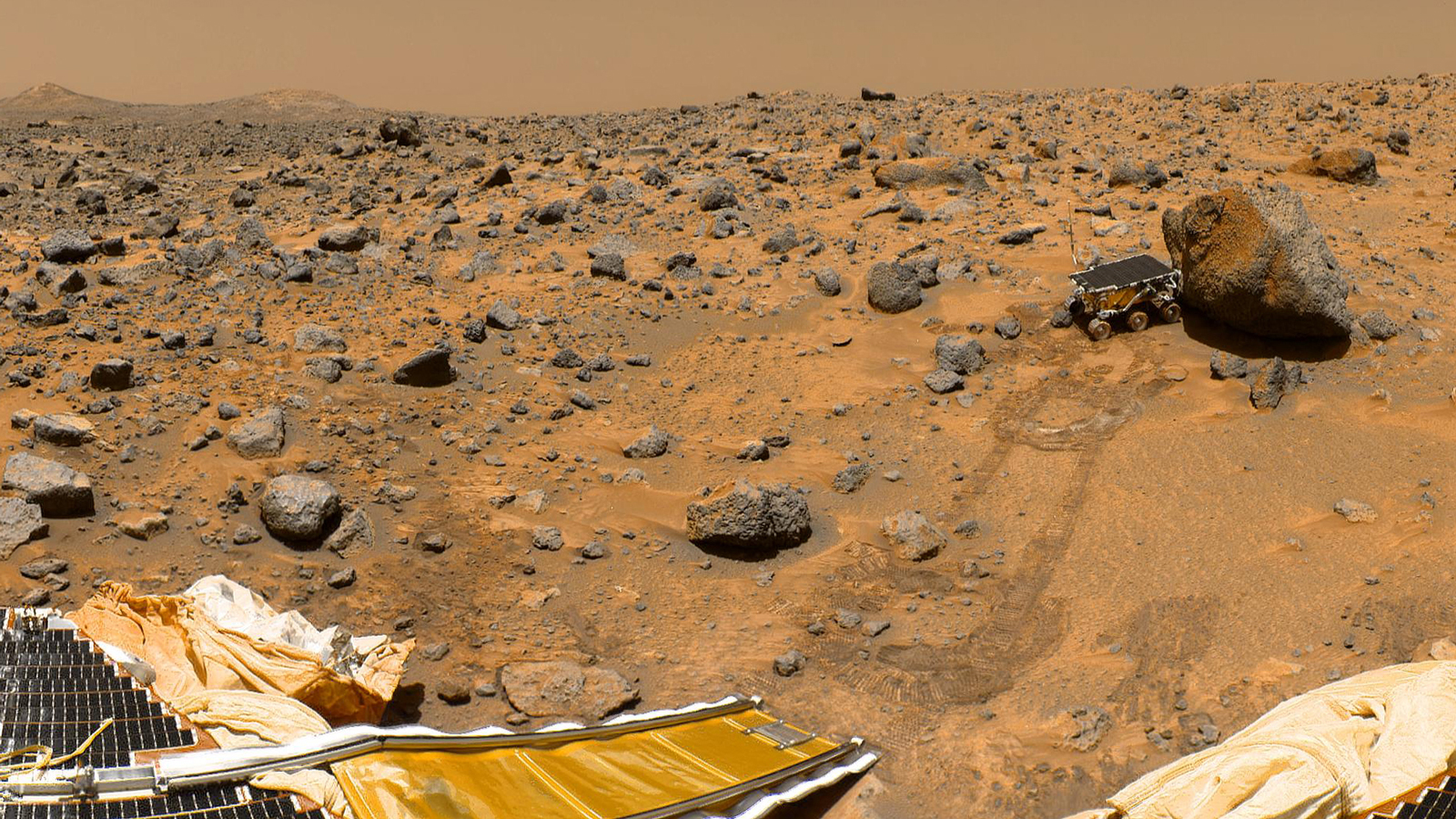
Mars exploration took a big leap 20 years ago today.
On July 4, 1997, NASA's Pathfinder mission touched down on the Red Planet, delivering an eponymous lander and a small rover called Sojourner — the agency's first wheeled Mars craft — to the surface.
Pathfinder was the first NASA mission to reach Mars successfully since the twin Viking 1 and Viking 2 landers/orbiters in the mid-1970s, and its success helped pave the way for a robotic Red Planet invasion. In the two decades since, eight other NASA robots have reached Mars, and five of them remain active today. [Occupy Mars: History of Robotic Red Planet Missions (Infographic)]
"Pathfinder initiated two decades of continuous Mars exploration, bringing us to the threshold of sample return and the possibility of humans on the first planet beyond Earth," Michael Meyer, lead scientist for NASA's Mars Exploration Program at the agency's headquarters in Washington, said in a statement.
Pathfinder launched on Dec. 4, 1996, embarking on an eight-month cruise to the Red Planet. After the lander touched down, the six-wheeled, microwave-oven-size Sojourner rover rolled down a ramp onto Mars' red dirt.
The images beamed home by the lander and rover racked up 200 million hits on the still-young internet between July 4 and July 8, 1997 — a traffic record at the time, NASA officials said.
The Pathfinder lander was designed to operate for one month, and Sojourner for just one week. But both robots kept going for three months, gathering data about Mars' atmosphere and climate, as well as the planet's geology and interior.
Get the Space.com Newsletter
Breaking space news, the latest updates on rocket launches, skywatching events and more!
The scientific bounty notwithstanding, the $264 million Pathfinder mission was primarily a technology demonstration that helped usher in a new era of relatively cheap, fast-development planetary efforts, NASA officials said.
"We needed to invent or re-invent 25 technologies for this mission in less than three years, and we knew that if we blew the cost cap, the mission would be cancelled," Pathfinder flight system manager and deputy project manager Brian Muirhead, of NASA's Jet Propulsion Laboratory in Pasadena, California, said in the same statement.
"Everybody who was part of the Mars Pathfinder project felt we'd done something extraordinary, against the odds," Muirhead added.
NASA reused these new technologies — which included Sojourner, advanced computers and an airbag landing system — in its next rover mission, which sent the golf-cart-size twins Spirit and Opportunity to the Red Planet.
Spirit and Opportunity landed a few weeks apart in January 2004 and soon began searching for signs of past water activity on the Red Planet. Both robots found plenty of such evidence, then kept rolling far beyond their three-month warranties: Spirit stopped communicating with Earth in March 2010, and Opportunity is still going strong today.
The other NASA robots that reached Mars after Pathfinder are the Phoenix lander and Curiosity rover, which touched down in May 2008 and August 2012, respectively; Mars Global Surveyor; Mars Odyssey; the Mars Reconnaissance Orbiter (MRO); and the Mars Atmosphere and Volatile EvolutioN Mission (MAVEN). The latter four are orbiters that arrived at the Red Planet in September 1997, October 2001, March 2006 and September 2014, respectively. (Two other NASA Red Planet missions, the Mars Climate Orbiter and the Mars Polar Lander, launched in the late 1990s but did not reach their destinations successfully.)
Opportunity, Curiosity, Odyssey, MRO and MAVEN are still operating today. So are Europe's Mars Express orbiter, India's Mars Orbiter Mission and the European/Russian ExoMars Trace Gas Orbiter. If all goes according to plan, these robots will be joined at Mars by several other spacecraft in the next few years: NASA plans to launch a lander called InSight in 2018, and both NASA and Europe (with Russia as a partner) plan to send life-hunting rovers toward the Red Planet in 2020.
Pathfinder's landing isn't the only big NASA event that occurred on July 4. On that date in 2005, for example, the agency's Deep Impact probe slammed an impactor into Comet Tempel 1 to investigate the icy body's composition. And on July 4 of last year, NASA's Juno spacecraft arrived in orbit around Jupiter.
Editor's note: Video produced by Space.com's Steve Spaleta.
Follow Mike Wall on Twitter @michaeldwall and Google+. Follow us @Spacedotcom, Facebook or Google+. Originally published on Space.com.
Join our Space Forums to keep talking space on the latest missions, night sky and more! And if you have a news tip, correction or comment, let us know at: community@space.com.

Michael Wall is a Senior Space Writer with Space.com and joined the team in 2010. He primarily covers exoplanets, spaceflight and military space, but has been known to dabble in the space art beat. His book about the search for alien life, "Out There," was published on Nov. 13, 2018. Before becoming a science writer, Michael worked as a herpetologist and wildlife biologist. He has a Ph.D. in evolutionary biology from the University of Sydney, Australia, a bachelor's degree from the University of Arizona, and a graduate certificate in science writing from the University of California, Santa Cruz. To find out what his latest project is, you can follow Michael on Twitter.









